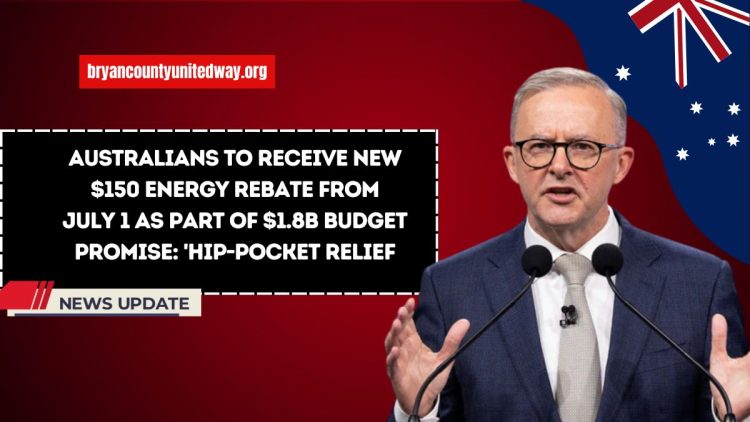The recent Federal Budget announcement includes a significant extension of the controversial energy rebates aimed at addressing the ongoing cost of living pressures.
While the $300 per year rebate will continue, only two more $75 installments will be distributed in the coming year.
Key Details of the Federal Budget Energy Relief
Prime Minister Anthony Albanese unveiled a $1.8 billion provision in the Federal Budget to ease the energy costs for every Australian household and small business.
This rebate extension is designed to cut $150 off energy bills over the next year. The current rebate program, which provided $75 every quarter, was originally set to conclude in 2024, with the last installment scheduled for April 1.
Quarterly Rebate Extensions
With the extension, two more quarterly payments will be made from July 1, ensuring that energy relief continues throughout the year. This decision forms part of the government’s broader strategy to provide cost-of-living relief while managing inflation.
Prime Minister Albanese stated: “This is another cost-of-living measure that my government is delivering for Australians while also putting downward pressure on inflation.”
Labor’s Election Promise and Inflation Impact
Before the 2022 federal election, Labor promised to reduce energy bills by $275 per year. However, Prime Minister Albanese pointed out that without these subsidies, the expected reduction in power bills would have been just 1.6 percent.
According to data from the Australian Bureau of Statistics, the initial rebate significantly impacted electricity costs, contributing to a 25.2 percent reduction in energy bills in 2024, as both state and federal governments worked together to ease the burden.
Albanese further emphasized that the reduction would have been far more modest if these subsidies had not been implemented, explaining: “Without the rebate, energy bills would have fallen by just 1.6 percent.”
The Economic Effect
This ongoing energy bill relief is part of a broader cost-of-living support strategy that aims to reduce inflation by mitigating the rising costs of essential services.
Public Opinion on Energy Rebate Extension
Recent Canstar Blue research reveals that 54 percent of Australians were unprepared for the possibility of higher energy bills if the federal rebate had ended.
In addition, more than 80 percent of Australians expressed support for extending the rebate, with 34 percent of respondents suggesting the introduction of a means test for eligibility.
Opposition Response to the Rebate
Opposition Leader Peter Dutton had previously criticized the rebate program. However, the Coalition has confirmed that it will not oppose the extension of the rebate.
Jane Hume, the shadow finance minister, stated that the Coalition would not stand in the way of this much-needed relief, despite Labor’s policies being blamed for high electricity and gas prices.
The Coalition has committed to implementing nuclear energy to help stabilize the power grid if elected. They plan to build seven reactors by 2050 and fast-track gas approvals to provide interim support.
Meanwhile, Labor intends to continue sourcing electricity from gas but will focus more heavily on renewable energy sources, including solar, wind, and batteries.
Energy Price Increases on the Horizon
The Australian Energy Regulator (AER) has also released its latest draft determination for the default market offer (DMO).
This determines the maximum energy prices for households in NSW, South Australia, and South East Queensland. The AER’s draft indicates that power bills could rise by as much as 8.9 percent in some areas.
Small Business Impact
For small businesses, the expected increase is between 4.2 and 8.2 percent, depending on the region. Additionally, the Essential Services Commission has released its draft recommendations for Victoria’s default offer (VDO).
The proposal suggests an average increase of 0.72 percent, with the annual electricity cost for a typical household (using 4000 kWh annually) rising from $1655 to $1667.
| Region | Expected Price Increase (%) | Average Annual Bill (4000kWh) |
|---|---|---|
| NSW, South Australia, SE Queensland | 2.5 – 8.9 | Varies by region |
| Victoria | 0.72 | $1667 |
The extension of the energy rebate under the Federal Budget offers crucial relief to households and small businesses struggling with rising energy costs.
While it will continue through two additional $75 quarterly payments, the broader context of rising energy prices and ongoing debates over the energy policy continue to shape the political landscape.
FAQs
What is the amount of the energy rebate under the new Federal Budget?
The $300 per year rebate will continue, with two $75 installments to be paid quarterly.
How much will energy bills increase in 2024?
Energy bills in areas like NSW, South Australia, and South East Queensland could rise by up to 8.9 percent.
Will the rebate be extended in the future?
Currently, the rebate is extended for two additional quarterly payments, but any further extensions will depend on future budget announcements.
What is the government’s stance on renewable energy?
Labor focuses on renewable energy sources like solar, wind, and batteries, whereas the Coalition advocates for nuclear energy and gas to stabilize the grid.
